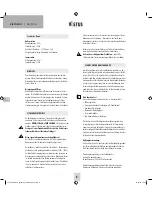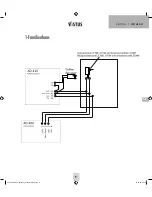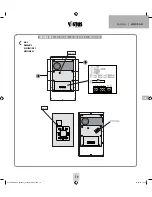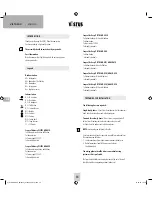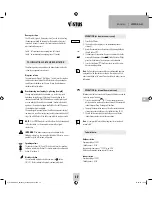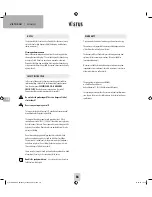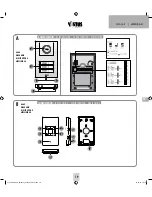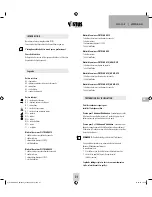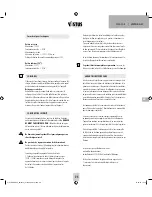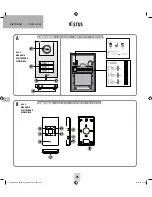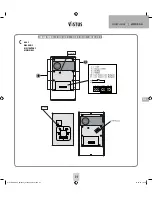
GB
VISTUS-AD | ENGLISH
16
INNENSTATION
INDOOR STATION
BOÎTIER INTÉRIEUR
BINNENSTATION
Connecting the door opener
For the connection of the door opener there is a floating NO contact at
the outdoor unit.
1. Via the operating voltage of the outdoor unit
Therefore connection 1 of the door opener is connected to terminal
11, connection 2 of the door opener to ground/GND (for example
terminal 21). Additionally a bridge is required from +15V (for
example A1) to terminal 10.
2. Using an external voltage source
(e.g. bell transformer)
Therefore separate lines from the external voltage source to the door
opener and the outdoor unit are needed. Connection 1 of the door
opener is directly connected to connection 1 of the external voltage
source. Connection 2 of the door opener is connected to terminal 11,
connection 2 of the external voltage source is connected
to terminal 10.
Note
: In order to prevent a door opening by tampering of the outdoor
station, we recommend the installation of the separately available
security door opener module SDO-10, which is mounted in the service
entrance box. The SDO-10 is also suitable for motor locking systems and
offers several adjustable door opening times and an
auto-door-open function.
Connecting the power supply
The power supply can be connected to either the indoor or the outdoor
station. Separate spring clips are present for this purpose.
It is also possible to connect the power supply directly to the signal line
e.g. from the fuse box to the outdoor and indoor units. The power supply
unit then needs to be connection with the ground (GND) and +15V.
Open power supply unit can supply up to 8 units with power.
Connecting a floor button
Any floor button that is present (normal closing contact) is connected in
parallel to the terminals ‘audio’ and ‘GND’.
On the 2- and 3-family versions please note that the correct audio line
is used (Audio1 and GND for family 1, Audio2 and GND for family 2 and
Audio3 and GND for family 3).
Note
: If a floor button is connected then an unchangeable ring tone
is played when the floor button is activated. This ring tone is fixed
and is not included in the ‘normal’ tones/melodies to make it easy to
differentiate.
Connecting the wireless expansion model VTX-BELL
The VTX-BELL can be used to send the bell signal wirelessly to the
receiver in the BELL series (currently BELL 200 RX, BELL 210 USB and
BELL 220 RX). The wireless module will be attached to the 3-pole plug
inside the indoor station (Figures C). For more information please see
the VTX-BELL instructions.
The plug for the VTX-Bell transmitter is located on the front of the main
PCB. To install the transmitter, unscrew the PCB from the housing.
Remove the eight screws which connect the PCB to the housing (Fig.
C No. 1).
Then remove the PCB and turn it over. A 3-pin plug is located at the
top of the PCB. It is labelled with Signal, GND and VCC. Attach the
transmitter connecting cable to the plug so that yellow is connected to
Signal, black to GND and red to VCC. Turn the PCB over again and route
the cable to the back of the PCB as shown in Fig. 2 B. Make sure that
the cable is not squeezed at any point. Screw the PCB back on using
the eight screws.
Now connect the transmitter to the cable and fix it in place with a piece
of adhesive tape.
Alternatively, the VTX-Bell can also be attached directly to the plug,
however the button for selecting the bell tone on the VTX-Bell will no
longer be easily accessible.
POSSIBLE SETTINGS ON THE OUTDOOR STATION
The outdoor station has the following possibilities of adjusting the
system to your personal circumstances:
Volume on the outdoor station
The potentiometer (Figure A ‚Volume / Lautstärke‘) is used to set
the speaking volume on the outdoor station. For full volume turn the
potentiometer carefully in a clockwise connection until it stops and turn
it back a little. Turning the potentiometer in an anti-clockwise direction
reduces the volume.
ID code
If several outdoor stations are used in parallel (e.g. on the gate and
on the house), the DIP switch is used to set the ID code (Figure A,
‚ID-CODE‘).
ID1 = Switch 1 ‘on’, Switch 2 ‘on’
ID2 = Switch 1 ‘on’, Switch 2 ‘off’
ID3 = Switch 1 ‘off’, Switch 2 ‘on’
VISTUS AD-400_I-Manual_210x240_Fin13.indd 16
01.03.16 15:19
Содержание VISTUS AD-4010
Страница 9: ...DE DEUTSCH VISTUS AD 9 1 Familienhaus VISTUS AD 400_I Manual_210x240_Fin13 indd 9 01 03 16 15 19...
Страница 10: ...VISTUS AD DEUTSCH DE 10 2 Familienhaus VISTUS AD 400_I Manual_210x240_Fin13 indd 10 01 03 16 15 19...
Страница 11: ...DE DEUTSCH VISTUS AD 11 3 Familienhaus VISTUS AD 400_I Manual_210x240_Fin13 indd 11 01 03 16 15 19...
Страница 33: ...VISTUS AD 33 33 1 family house VISTUS AD 400_I Manual_210x240_Fin13 indd 33 01 03 16 15 19...
Страница 34: ...VISTUS AD 34 34 2 family house VISTUS AD 400_I Manual_210x240_Fin13 indd 34 01 03 16 15 19...
Страница 35: ...VISTUS AD 35 35 3 family house VISTUS AD 400_I Manual_210x240_Fin13 indd 35 01 03 16 15 19...







